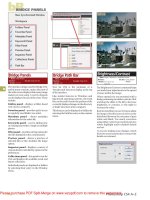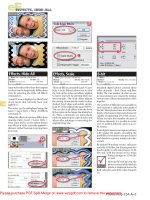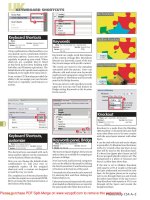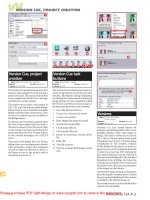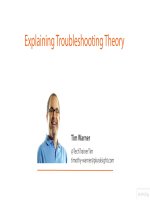IT training COLL white paper akka a to z khotailieu
Bạn đang xem bản rút gọn của tài liệu. Xem và tải ngay bản đầy đủ của tài liệu tại đây (6.56 MB, 35 trang )
TECHNICAL WHITE PAPER
Akka A to Z
An Architect’s Guide To Designing, Building,
And Running Reactive Systems
By Hugh McKee & Oliver White | Lightbend, Inc.
Table Of Contents
Executive Summary....................................................................................................................... 3
A Little History of Akka................................................................................................................... 4
Part 1: Akka Actors And The “Lives” They Lead............................................................................... 6
The Actor Model..............................................................................................................................................................................................6
Actor Supervision (Self-Healing)..................................................................................................................................................................9
Routing and Concurrency.......................................................................................................................................................................... 10
To Sum Up..................................................................................................................................................................................................... 12
Part 2: Streaming Workloads with Reactive Streams, Akka Streams, Akka HTTP, and Alpakka.......13
Reactive Streams and Akka Streams....................................................................................................................................................... 13
Akka Streams, Akka HTTP, and Alpakka...................................................................................................................................................14
To Sum Up ................................................................................................................................................................................................... 15
Part 3: Building a Cluster with Akka Cluster and Clustering Sharding.............................................16
Creating A Cluster......................................................................................................................................................................................... 16
Cluster Sharding............................................................................................................................................................................................17
To Sum Up ................................................................................................................................................................................................... 21
Part 4: Akka Cluster with Event Sourcing & CQRS, Publish/Subscribe, and Distributed Data...........22
Event Sourcing and CQRS.......................................................................................................................................................................... 22
Publish and Subscribe................................................................................................................................................................................ 23
Distributed Data........................................................................................................................................................................................... 24
To Sum Up ................................................................................................................................................................................................... 26
Part 5: Monoliths, Microliths, Lambdas, and Reactive Systems In Production................................27
Reactive Systems with Akka, Play, Lagom and Lightbend Commercial Features.......................................................................... 29
Commercial Features For Serious Enterprises...................................................................................................................................... 30
Akka Monitoring and Telemetry......................................................................................................................................................... 30
Akka Split Brain Resolver..................................................................................................................................................................... 31
Akka Thread Starvation Detector....................................................................................................................................................... 31
Akka Configuration Checker................................................................................................................................................................ 32
Akka Diagnostics Recorder.................................................................................................................................................................. 32
Akka Multi-DC Tooling (Cluster and Persistence)............................................................................................................................ 32
Additional Resources.................................................................................................................................................................................. 33
AKKA A TO Z: AN ARCHITECT’S GUIDE TO DESIGNING,
BUILDING, AND RUNNING REACTIVE SYSTEMS
2
Executive Summary
By now, you’ve probably heard of Akka, the JVM toolkit for building scalable, resilient and resource efficient applications in Java or Scala. With 16 open-source and commercial modules in the toolkit, Akka
takes developers from actors on a single JVM, all the way out to network partition healing and clusters of
servers distributed across fleets of JVMs. But with such a broad range of features, how can Architects and
Developers understand Akka from a high-level perspective?
At the end of this white paper, you will better understand Akka “from A to Z”, starting with a tour from the
humble actor and finishing all the way at the clustered systems level. Specifically, you will learn about:
›› How Akka Actors function, from creating systems to managing supervision and routing.
›› The way Akka embraces Reactive Streams with Akka Streams and Alpakka
›› How to build distributed, clustered systems with Akka, even incorporating clusters within clusters.
›› How various components of the Akka toolkit provide out-of-the-box solutions for distributed data,
distributed persistence, pub-sub, and ES/CQRS
›› Which commercial technologies are available for Akka, and how they work, as part of a Lightbend
subscription.
AKKA A TO Z: AN ARCHITECT’S GUIDE TO DESIGNING,
BUILDING, AND RUNNING REACTIVE SYSTEMS
3
A Little History of Akka
Believe it or not, Akka’s roots begin back in 1973 (approximately 8000 years ago in the IT world), in a
laboratory in MIT, where a mathematics Ph.D. named Carl Hewitt co-authored a paper called A Universal
Modular Actor Formalism for Artificial Intelligence. In it, he introduced a mathematical model that treats
“actors” as the universal primitives of concurrent computation1.
“[The Actor Model is] motivated by the prospect of highly parallel computing machines consisting of dozens, hundreds, or even thousands of independent microprocessors, each with its own local memory and communications processor,
communicating via a high-performance communications network.”
Carl Hewitt
At that time, low-latency, concurrent computations across a broad spectrum of cloud infrastructure was
not truly viable in a commercial setting. It wasn’t until much later that enterprise-grade cloud computing
came along.
In 2009, Lightbend co-founder and CTO, Jonas Bonér, created the Akka project as a way to bring a distributed, highly concurrent and event driven implementation of Hewitt’s Actor Model–as well as Erlang’s
implementation of it–to the JVM.
Now in 2018–just a year away from Akka’s 10th anniversary–we continue to support the goal of bringing
the power of multicore, asynchronous, self-healing and highly scalable systems to Java and Scala architects and developers–without having to know about all the low-level internal plumbing behind it all.
1 />
AKKA A TO Z: AN ARCHITECT’S GUIDE TO DESIGNING,
BUILDING, AND RUNNING REACTIVE SYSTEMS
4
Core OSS modules
Akka Actors
Akka Streams
Akka HTTP
Alpakka
Akka Cluster
Akka Cluster Sharding
Akka Persistence
Akka Distributed Data
Akka Multi-DC Cluster
Akka Management
Split Brain
Resolver
Diagnostics
Recorder
Configuration
Checker
Thread Starvation
Detector
Multi-DC
Persistence
Monitoring & Telemetry
The Akka toolkit contains a growing selection of open source modules,
as well as commercial modules to support the needs of enterprise
It’s important to note that Akka is a JVM toolkit/library, rather than a framework (e.g. like Play and
Lagom). While there are a selection of both open source and commercial components (part of Lightbend
Enterprise Suite), the focus of this paper will be on actors, streams and HTTP, clustering, persistence and
deployment concepts.
This journey will go from individual actors and how they behave through supervision and self healing,
through to the Reactive Streams initiative with Akka Streams, Akka HTTP and Alpakka, then into the world
of distributed persistence of event sourcing and CQRS, microservices, and finally distributed clusters and
how to manage, monitor and orchestrate them.
With this in mind, let’s start at the very beginning: Akka Actors.
AKKA A TO Z: AN ARCHITECT’S GUIDE TO DESIGNING,
BUILDING, AND RUNNING REACTIVE SYSTEMS
5
Part 1: Akka Actors And The “Lives” They Lead
The Actor Model
At the atomic or molecular level of Akka, we begin by taking a look at actors, which present a different
way of programming than what many of developers have grown up with. Most developers have learned
object-oriented programming, or maybe even functional programming, but for the most part, most of it
has been imperative and synchronous programming involving lots of threads and related elements.
The actor model brings in something that’s very different. An actor itself just a class, which can be implemented in Java or Scala. An actor has methods, but the big difference between an actor and what we’re
normally used to as software developers is that the methods on an actor are not directly accessible from
outside the actor.
Methods are not invoked on an actor directly, which takes some getting used to. The reason for this is that the
only way to talk to an actor is to send it a message, which is sent through the actor system that Akka provides.
Figure 1
With actors, messages are sent asynchronously, not synchronously, between actors. As shown in Figure 1,
messages are first deposited into a mailbox of pending messages for the actor to process. The actor
works through these messages one at a time, message after message after message, processing them all.
That’s all there is to basic mechanics of an actor. The end result is that an Akka system consists of a
bunch of actors that communicate with each other by sending each other messages.
AKKA A TO Z: AN ARCHITECT’S GUIDE TO DESIGNING,
BUILDING, AND RUNNING REACTIVE SYSTEMS
6
Figure 2
Here’s how it works: in Figure 2, actor A is sending a message to actor B. This is an asynchronous message, just like two people sending each other a text message. A sends B a text message, which is received,
letting A free to continue with other business.
A is not sitting in suspended animation waiting for a response from B, as may be seen in a typical method
invocation with object-oriented programming, where the caller waits for a response. In this case, A sends
a messages and it’s free to move on, do something else, or it can just stop doing anything.
Figure 3
In Figure 3, B gets the message from A that triggers some kind of a state change; perhaps actor B represents a bank account, and the message signalling a positive withdrawal arrived, meaning the state
change is the updated balance of that particular account. If desired, it’s possible to program B to send a
message back to A saying, “Hey I did what you asked me to do.”
In reality, actors A and B may be running in a distributed environment, so B could be on another machine
and unable to respond. Right from the very beginning, this raises the question about what to do; B needs to
get the message from A, complete its task, and maybe send a message back, but that might not happen.
AKKA A TO Z: AN ARCHITECT’S GUIDE TO DESIGNING,
BUILDING, AND RUNNING REACTIVE SYSTEMS
7
Figure 4
Figure 4 shows how A is able to report directly to Akka’s actor system with a request: “Hey I would like you
to schedule a message to be sent to me at some point in the future.” This could be milliseconds, seconds,
or some minutes. But a plan is in place for when A sends a message to B that it cannot respond to, a timeout message will be sent.
Figure 5
In Figure 5, A gets back this timeout message, which is one of two types of messages that A was created
to process: a response from B or a timeout message. In either case, A knows what to do when either one
of those two situations happen. This is different than exception handling, where most exceptions just get
thrown. In Akka, resilience is an architectural feature, not an afterthought.
AKKA A TO Z: AN ARCHITECT’S GUIDE TO DESIGNING,
BUILDING, AND RUNNING REACTIVE SYSTEMS
8
Actor Supervision (Self-Healing)
Figure 6
With resilience built into Akka as part of its design, now it’s time to look at Actor Supervision. Actors are
able to create other actors, forming actor hierarchies, as we can see in Figure 6. In this example, actor A,
which is considered to be a supervisor, is creating these multiple worker actors (W). This produces a “parent-child” or “supervisor-worker” relationship between A and the actors that it creates.
The relationship between the supervisor and its workers is a supervision strategy, so that if one of the
worker actors runs into a problem when processing a message it’s not the worker itself that handles
exceptions, it’s the supervisor that takes over. This supervision strategy is well-defined, but also customizable–there will always be a plan for what do you do in the case of an exception within a worker actor that
the supervisor reacts to.
The available responses for supervisor A that can be set up are to resume the worker actor if the exception really isn’t that dangerous, or reset the actor by restarting it, or it could say, “This is really a pretty
serious problem, I’m just going to stop this actor.” Furthermore, supervisor A can look at the exception
and say, “This is really bad. I’m not set up to handle this kind of a problem. I need to escalate this problem
up to my supervisor.”
So there’s this whole escalation hierarchy here that is available for problems that bubble up, depending
on the severity of it. All this is under the developer’s control as the implementer, and the thing to remember here is that there’s this well-defined way for handling problems.
A natural inclination for beginners to the actor system is to implement a hierarchy with actors that have
a lot of code in them, but as familiarity with the actor model developers over time, it becomes easier to
divide and conquer.
AKKA A TO Z: AN ARCHITECT’S GUIDE TO DESIGNING,
BUILDING, AND RUNNING REACTIVE SYSTEMS
9
Figure 7
One reason for dividing and conquering has to do with reducing risk. The actor hierarchy is built to delegate “risky” operations off to the edge.
In Figure 7 we have user A1, B1 and C3, with C3 is pushing down some risky behavior down into these D
actors (i.e. D3). The edge nodes here are red, signifying that these actors are doing risky things, for example talking over the network to a database. This is risky because the network can go down, the database
could go down, and many other things could go wrong.
By pushing that risky behavior off into worker actors, the actors above it are in a way somewhat shielded.
With actor hierarchies, work is delegated to provide more fine-grained specialization of actors, such as
pushing risky behavior off into the leaves of the tree.
Routing and Concurrency
Akka specializes in multi-threaded, multicore concurrency, making it simple to handle operations that we
would traditionally set up with multiple threads by hand. Things here can easily get complicated, so Akka
enables out-of-the-box concurrency without getting into a lot of the technical challenges of multi-threaded programming in Java and Scala.
AKKA A TO Z: AN ARCHITECT’S GUIDE TO DESIGNING,
BUILDING, AND RUNNING REACTIVE SYSTEMS
10
Figure 8
In Figure 8, we have actors A and B, and a router actor R, which has has created a bunch of workers so
A and B can get some work done. A sends a message to the router actor asking it to do something. The
router actor doesn’t actually do the work, but delegates it off to a worker actor.
Figure 9
While that worker is performing the task for A, now B sends a message to the router actor asking it to do
some work. In Figure 9, the router actor forwards that message off to one of its other workers and now we
have multi-threaded concurrency without any manual coding. From the perspective of A and B, R is doing
a lot of work and it’s doing a lot of work at the same time, but in reality R has, behind the scenes, delegated that work off to these actors.
AKKA A TO Z: AN ARCHITECT’S GUIDE TO DESIGNING,
BUILDING, AND RUNNING REACTIVE SYSTEMS
11
Figure 10
In Figure 10, we look again at Akka’s supervision strategy in this example. Let’s imagine that A sends a message to the router, which forwards that message off to a worker, but the worker runs into a problem.
In normal programming with the “try-catch” method, the caught exception would normally be sent to A;
however, with the actor system, it’s the supervisor that sees the exception. So A initially sent this message to
to R, which forwarded it off to the worker. The worker ran into a problem. It’s the supervisor actor R that sees
the exception, so A doesn’t get back the response back that it’s expecting.
This is where the timeout mechanism can be implemented, so that R can send a response back to A saying,
“Hey there’s a problem and I can’t do what you asked me to do”. Regardless, A is not seeing the exception
and the caller is not having to deal with an issue that may not best handled by the clients of the service.
With the actor model at the core of Akka, it’s clear that there is a lot of powerful built-in plumbing to manage
concurrency and resiliency. While this represents a different way of thinking, it’s a highly productive and safe
way to build distributed systems.
To Sum Up
In short, here are the key takeaways from this section:
›› Actors are message-driven, stateful building blocks that pass messages asynchronously.
›› Actors are lightweight and do not hold threads, unlike traditional synchronous and blocking
technologies
›› Actors may create other actors, and use native supervision hierarchies to support self-healing
(resilience) in the face of errors.
AKKA A TO Z: AN ARCHITECT’S GUIDE TO DESIGNING,
BUILDING, AND RUNNING REACTIVE SYSTEMS
12
Part 2: Streaming Workloads with Reactive Streams,
Akka Streams, Akka HTTP, and Alpakka
One of the most popular OSS modules of Akka came out just a few years ago: Akka Streams. Based on the
Reactive Streams initiative, which Lightbend spearheaded along with engineers from companies like Netflix, Oracle, Pivotal and more, Reactive Streams enables processing of data streams with backpressure.
Like TCP, backpressure prevents a producer from overloading a downstream consumer that can’t handle
anymore flow.
Reactive Streams and Akka Streams
Figure 11
In Figure 11, we see on the left (the Reactive Streams Java 9 terminology) a publisher, a subscriber, and
a processor, which are the main components of a stream. In JDK 9, this implementation is not intended
to be used directly, but rather as a foundational piece for streaming. Akka Streams is built on top of the
Reactive Streams standard, plus adding more functionality beyond that.
On the right side in Figure 11, representing the terminology used in Akka Streams, there are sources,
sinks, and flows, versus with Java there was a publisher, subscriber, and processor. It’s the same functionality, and Akka Streams brings the experience of Lightbend’s Akka team and the OSS community to add
functionality in the flow area. Akka Streams provides things that would be familiar to any functional programmer, like filter, and fold, and map, which are methods supplied with the flow for transforming data as
it flows through the stream.
AKKA A TO Z: AN ARCHITECT’S GUIDE TO DESIGNING,
BUILDING, AND RUNNING REACTIVE SYSTEMS
13
Akka Streams, Akka HTTP, and Alpakka
Figure 12
Akka HTTP is built on top of Akka Streams, which is a natural fit for an HTTP request which should be
transformed into an HTTP response (Figure 12). The flow is the transformation that occurs within the
stream, which also works with websockets to process messages as they’re coming in, or going out, using
Akka Streams and/or Akka HTTP.
For enterprise integrations, there is another project called Alpakka, which brings a Reactive, Akka
Streams-based alternative to Apache Camel. Similar to the Camel community, the open source community has heavily embraced building out different connectors (to the right) in order to create a backpressure
capable upgrade to traditional Camel endpoints.
For example, taking a source of Wikipedia images Alpakka can “enrich the data” and push it out to various
connectors, such as Amazon S3, Apache Kafka, or Microsoft Azure Storage Queue.
Connectors
• AMQP Connector
• File Connectors
• Apache Geode connector
• FTP Connector
• Apache Solr Connector
• HBase connector
• AWS DynamoDB Connector
• IronMq Connector
• AWS Kinesis Connector
• JMS Connector
• AWS Lambda Connector
• MongoDB Connector
• AWS S3 Connector
• MQTT Connector
• AWS SNS Connector
• OrientDB Connector
• AWS SQS Connector
• Server-sent Events (SSE) Connector
• Azure Storage Queue Connector
• Slick (JDBC) Connector
• Cassandra Connector
• Spring Web
• Elasticsearch Connector
• Unix Domain Socket Connector
AKKA A TO Z: AN ARCHITECT’S GUIDE TO DESIGNING,
BUILDING, AND RUNNING REACTIVE SYSTEMS
14
Alpakka supplies a lot of power in fairly concise code, using Akka Streams and Akka actors under the
covers to avoid dealing directly with low-level internals. With Akka Streams there is a more functional type
of programming to deal with flows of things, and in general, the data is passing through various functions
to perform different transformation operations.
To Sum Up
In short, here are the key takeaways from this section:
›› The Reactive Streams initiative seeks to provide backpressure to streaming workloads to avoid
overloading producers or consumers.
›› Akka Streams is a Reactive Streams implementation that provides a rich set of flow processing
transformations.
›› Built on Akka Streams, Akka HTTP and Alpakka are backpressure-enabled modules that provide
resilient HTTP server and enterprise integration functionality as part of the Akka ecosystem.
AKKA A TO Z: AN ARCHITECT’S GUIDE TO DESIGNING,
BUILDING, AND RUNNING REACTIVE SYSTEMS
15
Part 3: Building a Cluster with Akka Cluster
and Clustering Sharding
One of the most useful features of Akka for enterprise users is the creation of clusters. For those who
have been developing in Java for a long time, Akka opens up a universe where development is no longer
constrained to a single JVM: Akka-based applications behave as a single system running in a distributed
environment with multiple JVMs. Here is how that works...
Creating A Cluster
Figure 13
In Figure 13, there is a collection of JVMs that are running together as a single Akka cluster. They are aware of
each other, and monitor each other through a gossip protocol of heartbeats that keep an eye on everything,
described in greater detail in Figure 14.
Figure 14
AKKA A TO Z: AN ARCHITECT’S GUIDE TO DESIGNING,
BUILDING, AND RUNNING REACTIVE SYSTEMS
16
Here, the management of all these nodes within the cluster is handled by Akka itself. Akka knows when
nodes join or leave the cluster, and there’s a well-defined way for Akka to keep the system running when
the topology of the cluster changes. Developers and architects are participants in this methodology, but
the real use case is focused on how actors react to changes in the topology of the cluster without having
to worry about anything.
Cluster Sharding
Another interesting pattern of Akka actors that has been set up out of the box in Akka is cluster sharding.
Cluster sharding is used when distributing actors across several nodes in the cluster with the ability to
interact with them using their logical identifier, but without having to care about their physical location in
the cluster (which might also change over time).
Figure 15
In Figure 15 (left), imagine an IoT use case where each actor represents the state of a device or entity. There
may be a large collection of entities and a subset of those entities are currently in use. It would be best to
have the state of each device stored in memory, but they don’t fit on one machine. In Figure 15 (right) the
rectangular box represents a single node that’s too small for this large collection of actors to fit on.
It’s also likely that putting all these actors on a single machine is a poor choice--it would be better for the
system’s resilience and elasticity to be running across multiple machines. That way, if a node is lost, there
are other nodes that can pick up the slack while the system is running, with perhaps a momentary burp
while reacting to the loss of a node (as opposed to a total system failure).
Simultaneously, the actors on that node are recovering while the system as a whole keeps running without a complete failure out of a monolith horror story.
AKKA A TO Z: AN ARCHITECT’S GUIDE TO DESIGNING,
BUILDING, AND RUNNING REACTIVE SYSTEMS
17
Figure 16
As seen in Figure 16, cluster sharding enables a large collection of actors to be broken up into logical
shards. To use an IoT example, image that there’s some kind of device identifier from which a hash code
of it is taken. This then lets you do a modulo divide and that comes up with the shard ID for each one
of the entities. Cluster sharding uses a well-defined sharding strategy to take that logical collection and
distribute those shards across a cluster.
AKKA A TO Z: AN ARCHITECT’S GUIDE TO DESIGNING,
BUILDING, AND RUNNING REACTIVE SYSTEMS
18
Figure 17
In Figure 17, there is a cluster of four nodes where cluster sharding is handling where each shard is distributed across the cluster. It handles the routing of messages to each one of the individual actors (the small
blue dots) where an actor represents a particular entity, like a bank account or an IoT device
It really starts to get interesting when these shards that are distributed across the cluster and a node goes
down. When a node goes down, cluster sharding knows which shards were on that node and it helps in
the resurrection of the actors that were taken out by the loss of this node by redistributing those actors to
other nodes in the cluster.
Because cluster sharding manages of all of these shards and their distribution, developers don’t have to
worry about any of that. This leaves the focus on the recovery of the state of these actors–which is definable depending on the use case at hand. For example, if these actors each represent bank accounts, they
should be recreated on other nodes in the cluster its state (i.e. the current balance of this account) has to
be recovered. This is handled in part by Akka Persistence, which will be described later on in this paper.
AKKA A TO Z: AN ARCHITECT’S GUIDE TO DESIGNING,
BUILDING, AND RUNNING REACTIVE SYSTEMS
19
Figure 18
In Figure 18, we see how cluster sharding works by using a Shard Coordinator actor, shown in the bottom-left of the image. There is one Shard Coordinator for the entire cluster, which works with a Shard Region
Actor that exists on each node in the cluster.
This allows us to disregard where the specific entity actor is in the cluster when a message is sent it. When a
request comes in, there’s a load balancer in front of it that round-robins messages across the cluster. When
a message comes in for Entity 123 and it just happens to fall on node two, the Shard Region actor for node
two gets it and responds “I don’t know where this actor is. Where is it in the Cluster?”
Figure 19
In Figure 19, the Shard Region actor for node two then sends a message to the Cluster Singleton Shard
Coordinator asking, “Where is Entity 123 supposed to be distributed across all the Shards in the Cluster?”
The lookup process, determining where a given entity is located in a cluster, is done using a shard Id that
is computed from each incoming entity message. The ShardCoordinator decides which ShardRegion shall
own the Shard and informs that ShardRegion.
AKKA A TO Z: AN ARCHITECT’S GUIDE TO DESIGNING,
BUILDING, AND RUNNING REACTIVE SYSTEMS
20
From here, the Shard Coordinator sends a message back saying, “Oh, it’s in Region Three”, allowing the
Shard Region actor on node two to forward the messages saying, “Hey, here’s a message for Entity 123,
off to Shard Region Three.”
Now, the Shard Region actor on node three will have to go through the same cycle, because it doesn’t
know either. So, it asks the Shard Coordinator “Where is Entity 123?”. When the Shard Coordinator replies
that Entity 123 is on node three, then node three is updated with the fact that Entity 123 belongs on its
node. The beauty of this, again, is that developers only need to write the code to send a message to the
Shard Region, and that’s it.
Figure 20
As seen in Figure 20, Cluster Sharding handles the rest of it with intelligence built in to allow each Shard
Region to remember where the Shards are, so it doesn’t have to continually ask the Shard Coordinator
where a particular Shard is. Once it’s been told where a Shard is, all the Shard Regions remember.
The complexity of these interactions are in reality handled by just four different elements: the Shard Coordinator, the Shard Region, we’ve got the Shard, and we have the Actors themselves. These represent the
Cluster Singleton actor, the Node Singleton actor, and then the Sharded actors themselves.
To Sum Up
In short, here are the key takeaways from this section:
›› Akka’s Cluster features provide a host of functions for scaling your Reactive systems in a safe, and
supervised way.
›› Cluster Sharding is implemented for different use cases as a way to ensure state is maintained
when messages travel across various asynchronous boundaries.
›› Developers do not have to worry about the low level implementation of these interactions, since
Akka takes care of it natively.
AKKA A TO Z: AN ARCHITECT’S GUIDE TO DESIGNING,
BUILDING, AND RUNNING REACTIVE SYSTEMS
21
Part 4: Akka Cluster with Event Sourcing & CQRS,
Publish/Subscribe, and Distributed Data
Cluster sharding is a powerful and important tool for maintaining state across actor systems, but what
happens when you add data persistence and storage to the story? This is where Event Sourcing and CQRS
(Command Query Responsibility Segregation) enter the scene. These features have been gaining in popularity recently as distributed systems increase in adoption, and are provided in Akka as a different way of
working with persistence and microservices.
Event Sourcing and CQRS
Figure 21
Continuing with the Cluster Sharding example, in Figure 21 Akka Persistence is used to ensure that if we
lose a node and the actors have to be recreated, it’s possible to recover state with some kind of persistence store. Akka Persistence uses Event Sourcing–with an event log–to accomplish this.
When a command comes in, it gets routed to the Entity, by the Entity ID, through Cluster Sharding and
then when the message arrives at that actor, the actor is implementing Akka Persistence. Let’s return to
the bank account example where strong consistency is needed: in the Akka Persistence pattern there’s a
persister and in this case, we’re actually persisting the event that says “Here’s a deposit”.
A command is a request to do something in the future, whereas an event is saying, “yeah, it happened”.
What is being stored is the fact that it was done–the deposit was accepted, and the withdrawal from
somewhere else was accepted. Once the event is persisted in the event log, the entity itself updates its
state and, either incrementing or decrementing the balance.
AKKA A TO Z: AN ARCHITECT’S GUIDE TO DESIGNING,
BUILDING, AND RUNNING REACTIVE SYSTEMS
22
Figure 22
In Figure 22, another feature called Akka Persistence query is utilized, which looks at the query responsibility of CQRS–this is also known as the write side and the read side. The write side is the event log, the
read side is where data is stored in a more queryable way. Because an event log isn’t very queryable,
what’s happening here is that the events are being propagated from the event log into the read side. This
is non-transactional, meaning there isn’t a single database transaction, so there has to be some things
done to guarantee that events aren’t missed. This important feature is built into Akka Persistence query,
where the read side is pulling events from the event log, rather than the more brittle approach of pushing
events from the event log to the read side.
Publish and Subscribe
Akka has built-in features to ensure that commands and events are handled appropriately, called publish
and subscribe. In this case, more actors are added to the mix in order to handle this, including mediator
actors, published actors, and subscriber actors.
AKKA A TO Z: AN ARCHITECT’S GUIDE TO DESIGNING,
BUILDING, AND RUNNING REACTIVE SYSTEMS
23
Figure 23
If Figure 23, there is a mediator actor in each node in the cluster. There are N number of subscriber actors
that have registered some interest in a kind of event. Then there are publisher actors that publish an
event (i.e. send a message). The publisher simply sends a message to its local mediator actor on its local
node, and it’s done. These mediator actors know that there’s a cluster here, and they know that they’ve
got counterparts on other nodes within the cluster.
The mediator actor that first gets the message fires off that message off to its teammates across the cluster and says, “Hey, here’s an event that was published and someone needs to deal with that”. In the same
round-robin way as described in cluster sharding, each mediator actor then sends that message onto
whatever subscribers are available. This happens as a cascading series of messages across the cluster
using the actors designed for publish and subscribe, but developers don’t have to worry about any of this
since the local mediator actors already know what to do.
Distributed Data
Whereas Akka Persistence focuses on maintaining state for strong consistency, Akka Distributed Data
enables eventually consistent messages to be sent from actors on any node in the cluster without much
coordination. This is handled through the concept of Conflict-Free Replicated Data Types (CRDTs), which
are useful for things like counters, sets, maps and registers, where high read and write availability (partition tolerance) with low latency is needed.
AKKA A TO Z: AN ARCHITECT’S GUIDE TO DESIGNING,
BUILDING, AND RUNNING REACTIVE SYSTEMS
24
Figure 24
There are some restrictions on the kinds of data that you can use with Akka Distributed Data; for instance,
in an eventually consistent system a read may return an out-of-date value. Akka handles this by using
other types of actors that are distributed across the cluster. In Figure 24, there are replicator actors that
have been created on each node across the cluster.
In this image, there is an actor for each K value (K1, K2, K3) replicated across the cluster, along with an
updater actor on node 2. If the updater actor wants to know the value of K3, so it sends a message to the
replicator. The updater actor doesn’t know anything else in this environment, just that it’s sent a message
to its local replicator actor. The replicator actor retrieves the value from K3 and sends a message back to
the updater with the value.
Figure 25
In Figure 25, the updater actor requests a change in the value of K3. Now the situation has changed, because the new value of K3 must be replicated across the cluster for all instances of K3. The replicator actor
is cluster aware, so it knows that it has teammates on other nodes in the cluster. It forwards that update
message off to the other replicator actors, which are responsible for changing their local copy of K3.
From the developer perspective, it’s simply a message sent to the local replicator actor; the magic is happening automatically through the actions of the other actors, which is something that doesn’t have to be
coded for manually.
AKKA A TO Z: AN ARCHITECT’S GUIDE TO DESIGNING,
BUILDING, AND RUNNING REACTIVE SYSTEMS
25

